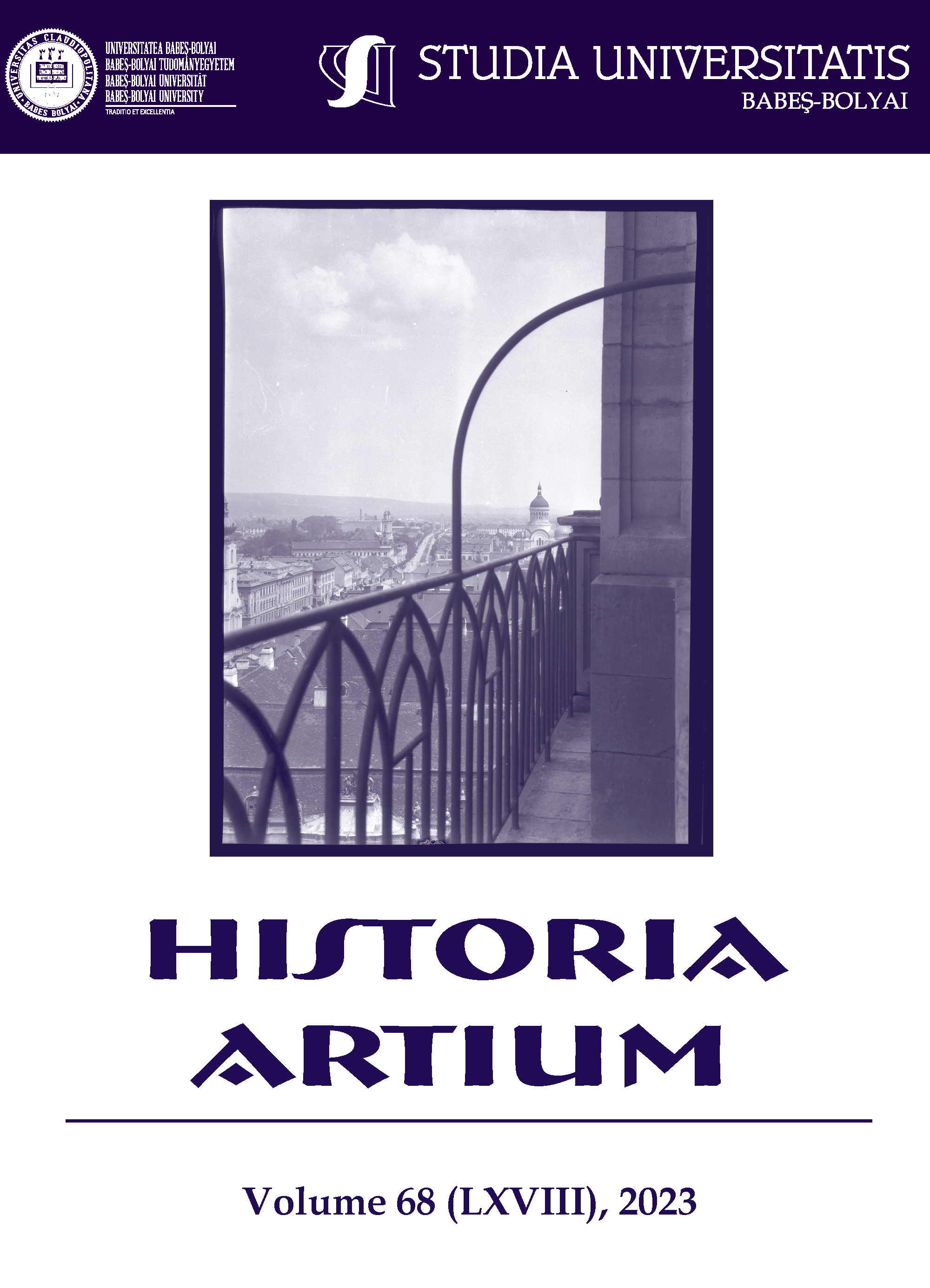The Visibility of a City in the Interwar Period. Scopic Regimes in the Photographs of Lajos Orbán (1897–1972) From Cluj
DOI:
https://doi.org/10.24193/subbhistart.2023.06Keywords:
amateur photography, visual culture, urban life, “flâneur”, scopic regime, landscape, human figuresAbstract
The Visibility of a City in the Interwar Period. Scopic Regimes in the Photographs of Lajos Orbán (1897–1972) from Cluj. Lajos Orbán was an amateur photographer, whose main body of work was produced starting from the 1920s when he became the employee of a local shop specialized in photographic equipment and member in local photographic societies, e.g. the Tessar Bowling Society. His photographs were displayed at international photo exhibitions, but he was organising regional photo contests and exhibitions as well. His photographs show the influence of the pictorialist photography, but traces of modernism or the new objectivism are present as well. These pictures became archival documents, and they are also important resources to the visual culture of Transylvania, the visual literacy of the people living in the interwar years. The paper offers an in depth analysis of the scopic regimes detectable in the photographic heritage of Lajos Orbán based on the ways human figures and spatial relations are represented in his pictures.
References
Belting, Hans. An Anthropology of Images. Picture, Medium, Body. Princeton, New Jersey: Princeton University Press, 2014. [2001].
Blos-Jáni Melinda. A családi filmezés genealógiája. Erdélyi amatőr médiagyakorlatok a fotózástól az új mozgóképfajtákig. Kolozsvár: Erdélyi Múzeum-Egyesület, 2015.
Boerdam, Jaap, and Martinius Warna Oosterbaan. “Family Photographs – a Sociological Approach.” The Netherlands Journal of Sociology 16 (1980): 95–119.
Csillag Gábor. “«Képek és képtelenségek» – a valóságábrázolás határai a turisztikai képi emlékekben.” In Helye(in)k, tárgya(in)k, képeink. A turizmus társadalomtudományos magyarázata, edited by Fejős Zoltán and Szijártó Zsolt, 73–80. Budapest: Néprajzi Múzeum, 2003.
Éjszaky Ödön. “Az amatőr fényképezés kezdete Kolozsvárt.” Erdély 1–2 (1933): 21–23.
Erdélyi Lajos (ed.), Teleki Samu Afrikában. Bukarest: Kriterion, 1977.
Ifj. Fanta. “Figyelő.” Művészeti Szalon 3, no. 6–7 (1928): 20–22.
Finta Zoltán. “A K. A. C. fotószakosztályának házi kiállítása.” Művészeti Szalon 3, no. 10 (1928): 10–11.
Füzi Izabella. A vurstlitól a moziig. A magyar vizuális tömegkultúra kibontakozása (1896–1914). Szeged: Pompeji, 2022.
Gaal György. Kolozsvár a századok sodrában. Várostörténeti kronológia. Kolozsvár: Kincses Kolozsvár Egyesület, Kriterion, 2016.
Gayer Zoltán. “Fényképaktusok. Amatőrképek a rendszerváltás előtt és után.” Replika 33–34 (1998): 87–102.
Gyáni Gábor. Az utca és a szalon. A társadalmi térhasználat Budapesten (1870–1940). Budapest: Új Mandátum Könyvkiadó, 1998.
Gyáni Gábor. “A reprezentatív város – a reprezentált város.” In Terek és szövegek. Újabb perspektívák a városkutatásban, edited by N. Kovács Tímea, Böhm Gábor, and Mester Tibor, 229–237. Budapest: Kijárat Kiadó, 2005.
Jay, Martin. “Scopic Regimes of Modernity.” In Vision and Visuality, edited by Hal Foster, 3–23. New York: The New Press, 1988.
Keszeg Anna. “Vizuális kultúra, visual literacy, media literacy, digital literacy. A vizuális műveltség tipológiája és kontextusai.” In Fogalom és kép II., edited by Egyed Péter and Gál László, 261–271. Kolozsvár: Kolozsvári Egyetemi Kiadó, 2011.
Keszeg, Anna. “A Magyar Királyság városainak látványstruktúrái a századforduló képeslapjain.” In Médiakultúra Közép-Kelet-Európában, edited by Kálai Sándor, 129–144. Kolozsvár: Erdélyi Múzeum-Egyesület, 2016.
Killyéni András. “Manouschek Ottó, a Sport-Világ első kolozsvári származású tudósítója.” ME.DOK 5, no. 3 (2010): 25–32.
Lefebvre, Martin. “Between Setting and Landscape in the Cinema.” In Landscape and Film, edited by Martin Lefebvre, 19–59. New York, London: Routledge 2006.
Lefebvre, Martin. “On Landscape in Narrative Cinema.” Canadian Journal of Film Studies 20, no. 1 (2011): 61–78.
Miklósi-Sikes Csaba. Fényképészek és műtermek Erdélyben 1839–1918: tanulmány és okmánytár. Székelyudvarhely: Haáz Rezső Alapítvány, 2001.
Mirzoeff, Nicholas. “The Subject of Visual Culture.” In The Visual Culture Reader, edited by Nicholas Mirzoeff, 3–23. London, New York: Routledge, 1998.
Mitchell, William J. Thomas. “The Pictorial Turn.” ArtForum 30, no. 7 (1992): 89–94.
Mitchell, William J. Thomas. Picture Theory. Chicago: University of Chicago Press, 1994.
Nancy, Jean-Luc. Portrait. New York: Fordham University Press, 2018.
Orbán Balázs. Székelyföld képekben, edited by Erdélyi Lajos. Bukarest: Kriterion, 1971.
Peternák Miklós. “Kis magyar fotótörténet.” 1997. http://marcheo.c3.hu/index.php?inc=obj&id=42&oid=26&ref=sub&roid=7, accessed February 15, 2017.
Sas Péter. Ónodi Veress Ferenc fényképész-műterme Kolozsvárt. Kolozsvár: Művelődés Kiadó, 2014.
Sümegi György. “Erdélyi plakátok 1940–41.” Székelyföld 15, no. 2 (2011): 143–147.
Újvári Dorottya. “Ferenc Veress, one of the Pioneers of Photography in Transylvania.” Uncommon Culture 5, no. 9–10 (2014): 142–147.
Újvári Dorottya. “Műkedvelő fényképészek és fotós társaságok a 20. század első felében Kolozsváron.” In Látható Kolozsvár: Orbán Lajos fotói a két világháború közötti városról, edited by Blos-Jáni Melinda, 42–55. Kolozsvár: Erdélyi Múzeum-Egyesület, Exit, 2018.
Downloads
Published
How to Cite
Issue
Section
License
Copyright (c) 2023 Studia Universitatis Babeș-Bolyai Historia Artium

This work is licensed under a Creative Commons Attribution-NonCommercial-NoDerivatives 4.0 International License.






